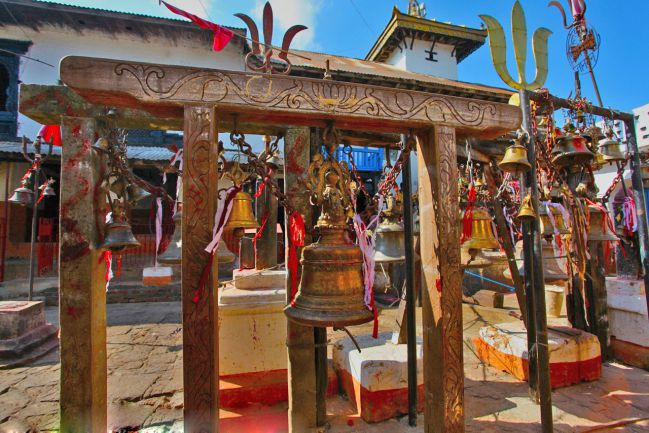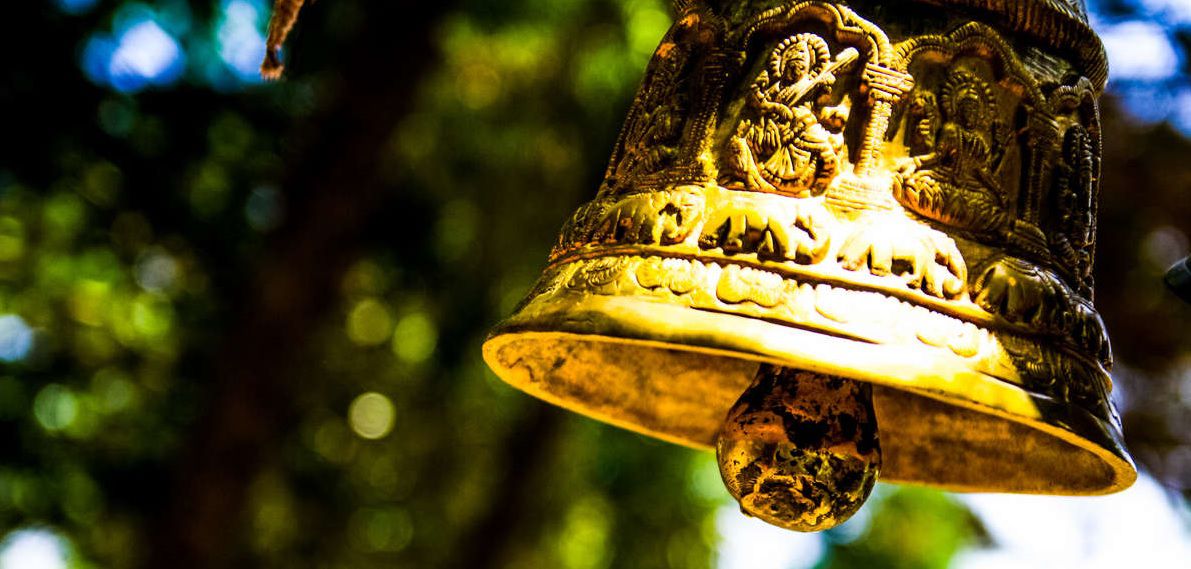No products in the cart.
It is an age old tradition to ring the bell of the temple upon entering its premises. Bell ringing is an ancient Vedic ritual and one can see multiple bells hanging over the domes in many Indian shrines. It is said that the devotees knock God’s entrance to ask permission upon entering his holy sanctum.
What is a bell?
Ghanta is the Sanskrit word for bell. Bell is a musical instrument made up of bronze or brass. It has a hollow interior and has a tang in it which creates sound. A temple bell or ghantais symbolic of antarala, the gap between sky and earth. Kansyaghanta, tala, ghatika, jayaghantika, kshudraghanta and krama are the types of bell mentioned in the Sanskrit literature.
Bells are mainly classified into two broad categories; one which can be hung on the hook. This type of bellcan be seen in the temples. The otherone is a small hand bell which can be rung by holding in the palm. This type of bell is normally used in the home sanctum.
Religious Importance
The bell is the spiritual abode of all Gods and Goddesses and it also acts as an instrument of many deities.
“Sarvavadyamayighantasarvadevamayiyatahtasmatsarvaprayatnenaghantanadamtukarayet”
(Bell is said to be the embodiment of all Gods and musical instruments, hence it should be sounded.)
The bell which has a handle in the shape of Vajra is known as Vajraghanta. In Buddhist monastery, the bell which has a Stupa shaped handle is used for prayers.
Interestingly, the bell with a sign of an eagle removes sorrows arising from snakes, fire and lightning. It is believed that this bell is much dearer to Lord Vishnu.
Ghanta is sounded before the actual puja and worship begins. A well-designed Ghanta or bell produce long strains of the sound OM or Aum. A bell is rung in a Hindu temple, during the waving of light in front of the deity, while bathing the deity and while offering food. Hindu devotees on entering the temple also hit the ghanta hanged in front of the sanctum sanctorum.
A Temple bell is another scientific phenomena; it is not just your ordinary metal. It is made of various metals including cadmium, lead, copper, zinc, nickel, chromium and manganese. The proportion at which each one of them mixed is real science behind a bell. Each of these bells is made to produce such a distinct sound that it can create unity of your left and right brain. The moment you ring that bell, bell produces sharp but lasting sound which lasts for minimum of seven seconds in echo mode good enough to touch your seven healing centers or chakras in your body.
There is an art and science of making bells to produce the requisite sounds. There are bells specially made to produce the long strains of the sound OM. The handle of a ghantadi signifies prãna – the vital force in the form of Hanumanji, Garud, Nandi or Chakra. During Garud sthãpanvidhi, the handle is offered pujan. A bell without a handle in one of these forms is forbidden in rituals, since it may augur misfortune. The body of the bell is said to represent the divinity of time (Ãgama-Kosha 1992 VI:99).
The moment bell sound happens your brain is emptied of all thoughts. Invariably you will enter state of Trance state where you are very receptive. This trance state is the one with awareness. You are so occupied in mind that only way to awaken you is with a Shock! And trust me Bell works as antidote to your mind .
Before you enter temple – to awake you and prepare you for taste of awareness is the real reason behind temple bell. In other words “it helps to ring to wake yourself up!” . To an extent fragrant generators, low light lamps etc form ecosystem to create awareness. So one of the purpose of ringing temple bell is to disconnect you from the worldly thoughts so that you are ready from within to invoke the divinity inside you. Ideally while ringing the bell you should remember the deity intensely. so that the vacuum (no-mind state) created by bell is filled with the thoughts of the deity. That is why most hindus chant the name of god (like jai sri ram or har har mahadev) while ringing the bell. The purpose is to bring your attention towards the god.
The most widespread belief is that the ghanta is sounded to invite the deity to accept the worship and prayers. Another belief is that it is to drive away the evil forces.
The sound made from a well-designed Ghanta is uninterrupted, reverberating, deep and sonorous. Symbolically, the body of the bell represents time – Ananta. The tongue of the bell symbolically represents Goddess Saraswathi. The handle of the Ghanta is considered to be the vital principle (Prana Shakti) and symbolically represents Hanuman, Garuda, Nandi or Chakra.
Even while doing the ritualistic aarati, we ring the bell. It is sometimes accompanied by the auspicious sounds of the conch and other musical instruments. An added significance of ringing the bell, conch and other instruments is that they help drown any inauspicious or irrelevant noises and comments that might disturb or distract the worshippers in their devotional ardour, concentration and inner peace.

As we start the daily ritualistic worship (pooja) we ring the bell, chanting the following verse from Aagma Shastra:
“Aagamaarthamtu devaanaam
gamanaarthamtu rakshasaam
Kurve ghantaaravam tatra
devataahvaahna lakshanam”
Translation: I ring this bell indicating the invocation of divinity, So that virtuous and noble forces enter (my home and heart); and the demonic and evil forces from within and without, depart.
According to the Skandpuran, the ringing of temple bells absolves man from sins committed over hundred births. Let us now see how the energy is emitted from the bell and what exactly happens with the help of a subtle drawing.
The dome shaped body of the bell and the clapper when strike with each other create circles of chaitanya which are projected in the atmosphere. The sound generated simultaneously also emits frequencies of chaitanya predominant in Akash tattva (absolute ether element). The stroke of clapper emits divine energy rays. The divine energy and chaitanya generated by the sound of bell drives away the negative energies.
The number of times the bell should be sounded depends on the number of letters in the mantra; accordingly the bell should be sounded 8,16,24, or 32 times. In Āgama Shastra it is mentioned that bell should be made of pancha lauha – five metals, namely, copper, silver, gold, brass and iron. These 5 metals represent the pancha bhoota.
Associated Legends of Bells in Temples
1. Lord Krishna saved the inhabitants of Gokul from the anger of Indra, during the time of Govardhana puja, by lifting the Govardhana Mountain. After this incident, the bell which was tied to the neck of Iravata, elephant of Indra, was gifted by Him to Krishna. The same is mentioned in the following verse,
Athopavahyadaya ghantam airavatad gajat
– (Brahma P. 188.36 ab)
This is considered as the beginning of the use of a bell in deity worship.
2. Before the battle of Mahabharata, Lord Krishna, who was supporting the Pandavas, went to meet King Jarasan for his support in the war. The King was a Brahmin and he believed that it was his duty to fulfill every wish that falls on his ears while performing rituals during sunset. So, to stop people from exploiting this rule (niyam), he appointed a guard who would not allow anyone to enter his room at the time of the rituals.
Lord Krishna, knowing all this, went to meet the King at the time of sunset. The guard stopped him saying that nobody (even Krishna) was allowed to enter the room at that hour. Krishna, attempting to persuade the guard to let him in, offered to fulfill the guard’s one wish in return of this. The guard asked Krishna, “Let me be your guard then. No disciple of yours should be allowed to meet you without my consent.” And the guard’s consent is believed to be signaled by the ringing of the bell.He considered being Lord Krishna’s guard a very honourable thing. Krishna granted the guard his wish and the guard allowed him to the King. Krishna put forward his wish in front of the King which he couldn’t refuse and thus he supported the Pandavas in the war.
So the bell is believed to be held by the guard and that Lord will pay attention to the prayers of his disciple only after the bell has been rung.
Conclusion
Bells or Ghantas continue to be an important part of our temples from time immemorial. It is always interesting to know that scientific reasons exist behind such rituals which started centuries ago and continues to be performed by us.






